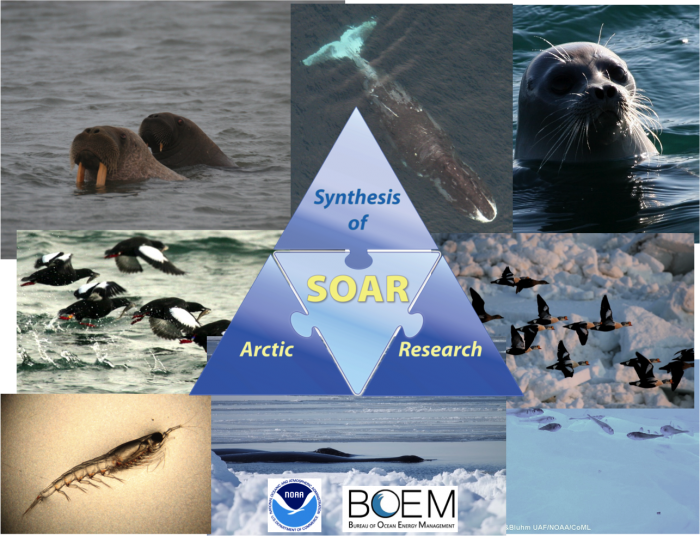The Synthesis of Arctic Research (SOAR) gains momentum with a second volume devoted to an interdisciplinary look at the new normal Pacific Arctic.
By: Lisa Sheffield Guy, ARCUS Project Manager and Synthesis of Arctic Research (SOAR) Coordinator
University of Washington, Joint Institute for the Study of the Atmosphere and Ocean and NOAA, Pacific Marine Environmental Lab
The Synthesis of Arctic Research (SOAR), led by NOAA scientists Sue Moore and Phyllis Stabeno, and supported by the Bureau of Ocean Energy Management (BOEM), was initiated in 2011 to capture the conditions of the changing Pacific Arctic using completed and ongoing research. The effort takes a holistic look at the "new normal" Pacific Arctic of the last decade, which now has a longer open-water season with reduced sea ice thickness and extent, increased primary production, and observed changes in abundance and behavior of Arctic species. The goal of SOAR is to increase scientific understanding of the relationships among oceanographic conditions (i.e., physics, chemistry, sea ice), benthic organisms, lower trophic pelagic species (i.e., forage fish and zooplankton), and higher trophic species (i.e., seabirds, walrus, whales) in the Pacific Arctic.

SOAR began with a three-day synthesis workshop held in Anchorage during March 2012. More than 50 Arctic experts from a broad range of disciplines, and from both the scientific and local communities, convened to identify science themes and relevant datasets, and to form synthesis teams to address high-priority questions about the new normal Pacific Arctic. During the workshop, draft themes were identified and 20 synthesis topics were proposed. The Eos Meeting Report is available here.
Following the workshop, synthesis teams met individually to share data and integrate information. The first phase of the synthesis was completed in summer 2015, and findings were published in a special issue of Progress in Oceanography comprised of 17 papers on topics ranging from ocean physics to whales. The synthesis was structured around three themes: 1) observations and models of sea ice loss and effects on primary production (five papers); 2) the response of mid-level trophic species to the new normal Arctic (five papers); and 3) responses of upper trophic level species (six papers). The issue uses a multi-disciplinary approach to explore how biophysical changes such as reductions in seasonal ice cover, warmer ocean temperatures, and increases in primary production and ocean acidification are reflected in changes in body condition, habitat use, and seasonal timing of upper trophic level species. Several articles, including the Special Issue overview by Moore and Stabeno, are available via open access here.
The second and final phase of SOAR extends this synthesis effort in a new special issue of Deep Sea Research II – Topical Studies in Oceanography. Building on the foundation of the original three SOAR themes, six papers will focus on observations and models of sea ice loss and effects on primary production, three papers focus on the response of mid-level trophic species to the 'new state' of the Arctic, and nine papers focus on the responses of upper trophic level species.
A summary of major SOAR findings, including what the new normal Pacific Arctic looks like and how Arctic marine life is responding to changes, was recently published in Eos and is available here.
A complete list of SOAR Phase II special issue papers and contributors is available here.
For more information, please contact Sue Moore, NOAA/NMFS at sue.moore [at] noaa.gov or Phyllis Stabeno, NOAA/PMEL at Phyllis.stabeno [at] noaa.gov.
